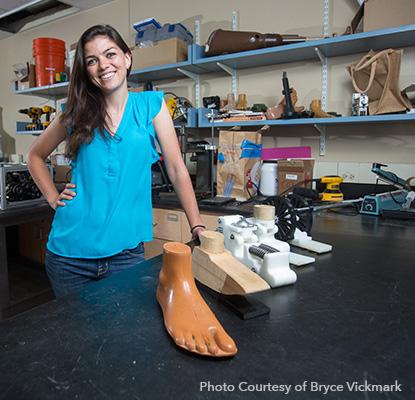Katy Olesnavage
Katy Olesnavage, originally from Ferndale, Michigan has always enjoyed building things. Her earliest creation was a robot Halloween costume that included an electric switch made from a paperclip and metal brads. When the robot flipped, it lit up transparency sheets reading “Trick or Treat” and “Thank You.” She also created a tissue-box hovercraft powered by a shop vacuum cleaner and a shoebox car driven by a motor repurposed from her ballerina Barbie doll’s twirling platform. Later, she made simple robots from LEGO sensor kits supplied by her father, a high school electronics teacher in the Detroit public schools.
Katy joined the robotics team in high school, part of the national For Inspiration & Recognition of Science & Technology (FIRST) competition that encourages teen teams to build and program robots. At that point, she knew she wanted to study mechanical engineering with a focus on design.
Katy attended a public high school in an inner-ring suburb of Detroit with limited options for upper-level math and science classes. With the help of a few very supportive teachers, she started teaching herself from advanced math textbooks and scored a perfect 5 on the Advanced Placement Calculus BC exam during her sophomore year. She spent the next two years taking math and physics courses at a local university while still completing high school.
The effort paid off. Katy received her bachelor’s and master’s degrees in mechanical engineering in 2012 and 2014 from MIT, and she expects to receive her PhD in the same subject in September 2017. Her dissertation focused on a new design method for a low-cost, high-performance passive prosthetic foot that better replicates physiological gait kinematics, enabling persons with amputations to walk more naturally. Her dissertation work was foundational to her selection as the recipient of the 2017 $15,000 Lemelson-MIT Student Prize in the “Cure it!” category.
Her other inventions include a modular, remotely operated underwater vehicle and an electromagnetic tissue damage measurement and feedback system that she produced as part of a student team for a chief surgeon at a Boston-area hospital. She also developed and deployed a system to pinpoint where precious fresh water was seeping into the ocean around the Mediterranean island of Cyprus, and served as a mechanical-engineering intern on Google’s Street View Hardware Team. Finally, she’s a long-time member and current president of the 88-member MIT Cycling Club.
After completing her PhD, Katy will join SpaceX as part of the Crew Dragon program. The prosthetic foot project will be carried on by other graduate students in her lab.


